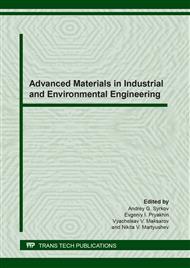[1]
V.N. Shinkin, A.P. Kolikov, Modeling the process of forming a workpiece for large diameter pipes, Steel 1 (2011) 54-58.
Google Scholar
[2]
G.G. Popov, A.V. Kasyanov, V.I. Bolobov, E.A. Krivokrysenko, Study of factors enabling initiation and behavior of grooving corrosion, E3S Web Conf. 121 (2019). DOI: https://doi.org/10.1051/e3sconf/201912103004.
DOI: 10.1051/e3sconf/201912103004
Google Scholar
[3]
A.P. Medvedev, A.N. Markin, About enhanced corrosion of pipelines of oil recovery systems of Oil and Gas Production Department Belozerneft, Oil industry 11 (1995) 23-24.
Google Scholar
[4]
L.B. Klisenko, A. P. Lapshin, D. V. Kudrin, Probable causes of the formation of grooving corrosion in oil pipelines identified during technical diagnostics, Modern Science: Actual Problems and Solutions 9 (22) (2015).
Google Scholar
[5]
A.D. Tomlenov, Theory of Plastic Deformation of Metals, Metallurgy, Moscow, (1972).
Google Scholar
[6]
N.A. Shaposhnikov, Mechanical Tests of Metals, State Scientific and Technical Publishing House of Engineering Literature Mashgiz, Moscow – Leningrad, (1951).
Google Scholar
[7]
K.A. Soady, Life assessment methodologies incorporating shot peening process effects: mechanistic consideration of residual stresses and strain hardening. 1. Effect of shot peening on fatigue resistance, Mater. Sci. Technol. 6(29) (2013) 673-651. DOI: https://doi.org/10.1179/1743284713Y.0000000222.
DOI: 10.1179/1743284713y.0000000222
Google Scholar
[8]
I. Altenberger, R. K. Nalla, Y. Sano, On the affect of deep-rolling and laser-peening on the stress-controlled low-and high-cycle fatigue behavior of Ti-6-Al-4V at elevated temperatures up to 550 °C, Intern. J. Fatigue 44 (2012) 292-302.
DOI: 10.1016/j.ijfatigue.2012.03.008
Google Scholar
[9]
R.A. Brockman, W. R. Braisted, S. E. Olson et al., Prediction and characterization of residual stresses from laser shock peening, Intern. J. Fatigue 36 (2012) 96-108. DOI: https://doi.org/10.1016/j.ijfatigue.2011.08.011.
DOI: 10.1016/j.ijfatigue.2011.08.011
Google Scholar
[10]
R.C. McClung, A literature survey on the stability and significance of residual stresses during fatigue, Fatigue Fract. Eng. Mater. Struct. 30 (2007) 173-205. DOI: https://doi.org/10.11111/j.1406-2695.2007.01102.x.
DOI: 10.1111/j.1460-2695.2007.01102.x
Google Scholar
[11]
M.A. Terres, N. Laalai, H. Sidhom, Effect of hitriding and shot peening on the fatigue behavior of 42CrMo4 steel: Experimental analysis and predictive approach, Mater. Design. 35 (2012) 741-748. DOI: https://doi.org/10.1016/j.matdes.2011.09.055.
DOI: 10.1016/j.matdes.2011.09.055
Google Scholar
[12]
V.F. Pavlov, V.V. Kirpichev, C. Vakulyuk, Prediction of Fatigue Resistance of Surface Hardened Parts by Residual Stresses, Publishing House SCNRAN, Samara, (2012).
Google Scholar
[13]
B.A. Kravchenko, V.G. Krutsilo, G.N. Gutman, Thermoplastic Hardening – Reserve for Increasing the Strength and Reliability of Machine Parts, Samara State Technical University, Samara, (2000).
Google Scholar
[14]
S.P. Burkin, G.V. Shimov, E. A. Andryukova, B91 Residual Stresses in Metal Products: A Training Manual, Ural University, Yekaterinburg, (2015).
Google Scholar
[15]
A.A. Halimov, Determination of residual stresses after repair of stressed structural elements of equipment and pipelines, Oilfield Business 12 (2008) 46-48.
Google Scholar
[16]
E.M. Gutman, Mechanochemistry of metals and corrosion protection, Metallurgy, Moscow, (1981).
Google Scholar
[17]
E. M. Gutman, R. S. Zainullin, R. A. Zaripov, Kinetics of mechanochemical fracture and durability of tensile structural elements during elastoplastic deformations, Physics-chemical mechanics of materials 2 (1984).
Google Scholar
[18]
E. M. Gutman, R. S. Zainullin, Methodology for calculating the stock of corrosion wear of thin-walled vessels and pipelines, Chemical and Petroleum Engineering 11 (1983) 38-40.
Google Scholar
[19]
I.G. Ovchinnikov, Mechanics of plates and shells subject to corrosion wear, SPTI, Saratov, (1991).
Google Scholar
[20]
S.V. Zhukov, V. S. Zhukov, R.F. Patent 2,079,825 (1997).
Google Scholar
[21]
S.V. Zhukov, V. S. Zhukov, N. N. Kopitsa, R.F. Patent 2,195,636 (2001).
Google Scholar
[22]
Yo. Sakai, H. Unishi, T. Yahata, Non-destructive method of stress evaluation in pipelines using magnetic anisotropy sensor, JFE Technical report 3 (2004) 47-53.
Google Scholar
[23]
Y.I. Evstratikova, V.E. Nikulin, Monitoring of residual welding stresses using the magnetoanisotropic method after applying ultrasonic impact processing, Welding and Diagnostics (2019).
Google Scholar
[24]
A. P. Stepanov, M. A. Stepanov, The method of magnetic control and diagnostics of the stress state of elements of steel structures having an axisymmetric section, Modern technologies, System analysis, Modeling 1(49) (2016) 60-68.
Google Scholar
[25]
V.N. Shinkin, Strength of Materials, Simple and Complex Types of Deformations in Metallurgy, MISiS, Moscow, (2008).
Google Scholar


